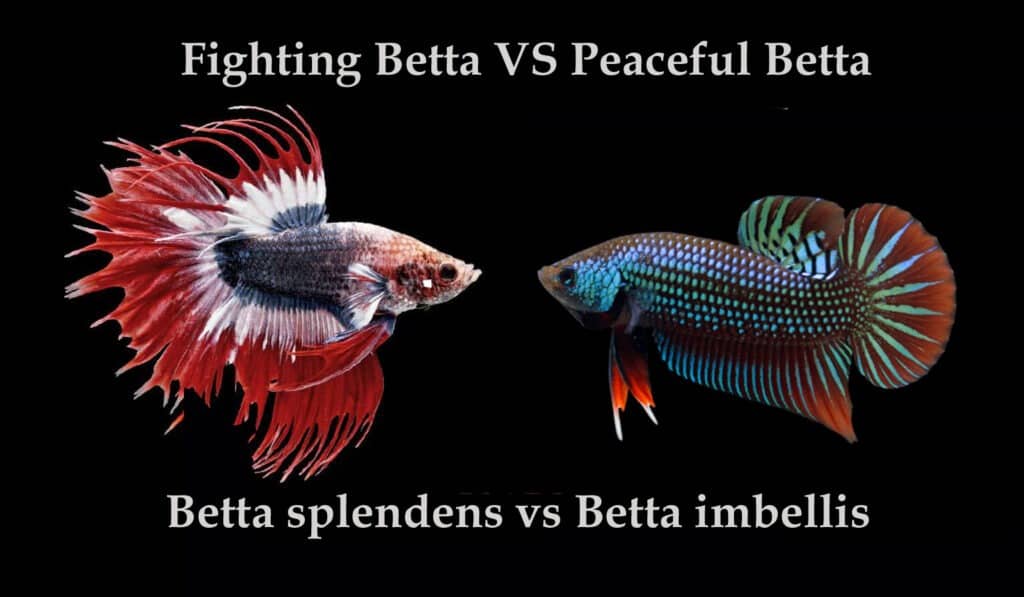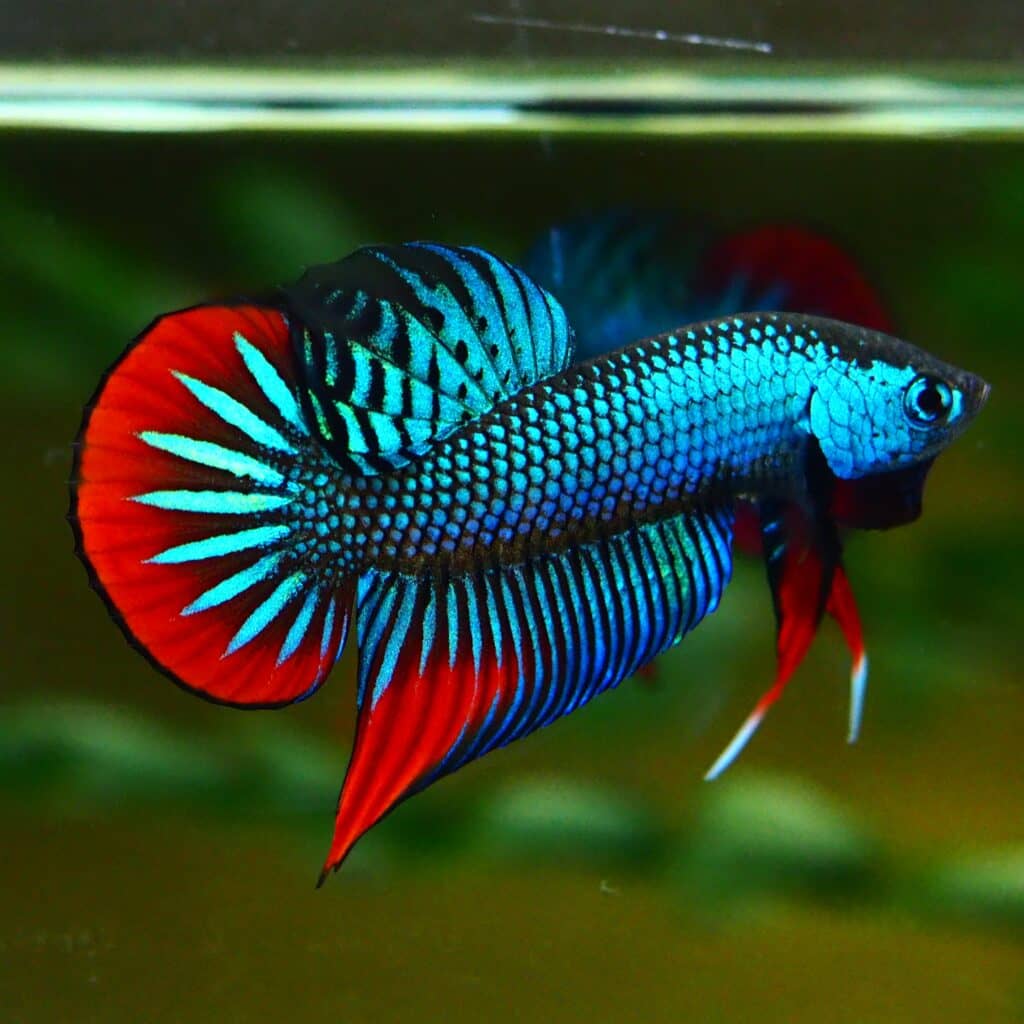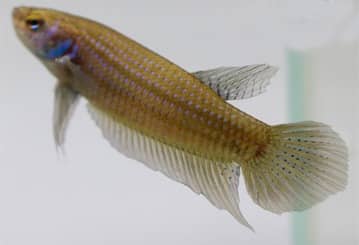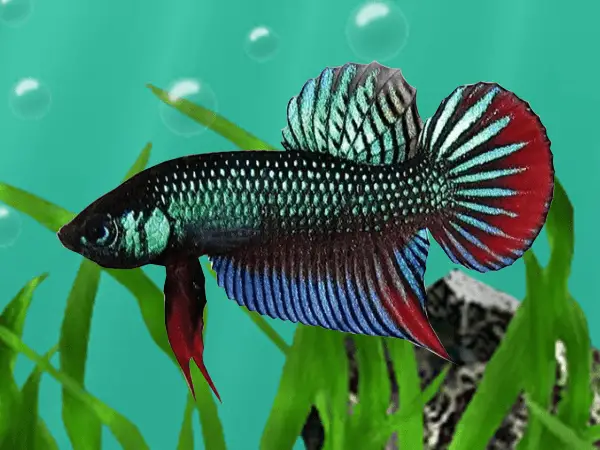Without doubt, fighter fish or Betta fish are one of the best-selling aquarium fish species in the world. They are famous for their gorgeous fin coloration, the shape of the fins and color pattern in the body. Most importantly, Betta fish are famous for their aggressive behavior. Special Betta splendid are known for the aggressive territorial behavior of male.
They behave their territorial attitude with other species as well as the same species male animal. The battle between two Betta species can be gruesome and can end up the death of one fish. Whether you believe it or not among this hormonal fighter fish there are calmer sibling known as Betta imbellis. B. imbellis belongs to the same family as B.splendens.

Yes, angry B.splendens has a cool cousin. Same as in human families this B. imbellis is much calmer and well-manned than its other cousins. B. imbellis also know as “cresent Betta” due to its red outlined, rounded caudal fin.
While B.splendens hate shares its space with other individuals, B. imbellis wouldn’t mind sharing its space with other individuals, no matter they are the same or different species. This particular Betta species is small in size and only show its striking body colour only during mating seasons. When building their bubble nest during their mating season, B. imbellis are a bit aggressive toward other cohabitants.
But this does not happen if they are not provoked. The bottom line is unless they are provoked; they are the nicest Betta fish in the world.
One look Care guide
Jump To
- 1 One look Care guide
- 2 How to separate Betta imbellis vs Betta splendens
- 3 Where betta imbellis from ?
- 4 Taxonomy
- 5 The common feature between you and B. imbellis
- 6 How to feed Betta imbellis
- 7 Betta imbellis Feeding Schedule
- 8 How long Betta imbellis live
- 9 Do Betta imbellis build bubble nests?
- 10 Feeding fry
- 11 Betta imbellis mating story
- 12 Tank preparation
- 13 Water quality For Betta imbellis
- 14 Can Betta Imbellis Go In Community Tank
- 15 Betta imbellis male and female
- 16 Betta Imbellis For Sale
- 17 Conclusion
| Scientific name | Betta Imbellis |
| Common names | Wild betta |
| Care level | Easy to Moderate level |
| Native to | Thailand, Southeast Asia |
| Type | Air brooder fish |
| Color | Black, red, blue |
| Life expectancy | 3-5 years |
| Tank size | 10 Gallons aquarium (38 liters) , Groups can be housed in a 30 gallon tank |
| Preferred temperature | 20 -28 °C (68-82.4°F) |
| pH | 6.5 – 7.5 |
| Other water parameters ammonia, Nitrate, Nitrite | Zero level (0) |
| Water | GH between 5 – 20 DH or 70-300 ppm |
| Size | Male 5-9 cm Female 5-6 cm (depend in season) |
| Growth rate | Medium |
| Temperament | Peaceful when alone |
| Recommended tank mates | Poecilia, Black Tetras, Bloodfin Tetras, Catfish, Croaking Gourami, and Rasboras. |
| Preferred food | Live feed ( Brine shrimp, Daphnia, and bloodworm) Frozen foods ( Brine shrimp, Daphnia, and bloodworm) Freeze-dried foods ( Brine shrimp, Daphnia, and bloodworm) |
| Feeding frequency | Feeds around 12 hours apart, fast for 24 hours once every 10-14 days |
| Breeding | Bubble nest builders |
| Stocking Ratio | 1:1 M:F / 2:3 M:F |
| Identification | They have green or blue gill plates with no wild spots on the tail rays. Same as wild betta |
How to separate Betta imbellis vs Betta splendens

It isn’t easy to separate them from their siblings. They show great similarities with B.splendens. However, their behaviors are totally opposite. They are the same in appearance (as in some human families). Sometimes well-experienced aquarists also mixed up these two species.imbellis body coloration varies among green, grey, and black colors. Sometimes they have patches of pale red plus blue. The fins of the fish are brighter in color with blue bolder, in some fish fins can have edges with bright red.
Same as other Betta species males usually have larger fins and display brighter color fins than the females. know how fin shape works
The Betta imbellis have round fins, and caudal fin shaped like a crescent. The other fins are also rounded and short. Meanwhile, Betta splendens, have long, flowing fins. So if you have good eyes, it is not hard to separate them at all. Apart from the color variation, these peaceful species do not grow above 5 cm in normal conditions. This is a much smaller body size compared with other Betta species.
Where betta imbellis from ?
As well to B.splendens, B. imbellis are originally from small swamps, and shallow ponds in parts of Asia. They have been captivity bred for many generations to better color than we see today. More specifically, these Betta species are from wetlands in the area surrounding Kuala Lumpur, Malaysia. They can also be naturally found in Thailand, Peninsular Malaysia, and northern Sumatra.
Taxonomy
| Kingdom | Animalia |
| Phylum | Chordata |
| Class | Actinopterygii |
| Order | Anabantiformes |
| Family | Osphronemidae |
| Genus | Betta |
| Species | Betta imbellis |
The common feature between you and B. imbellis
Yes, you and B. imbellis have something in common. We both can use atmospheric air. This is not common among other fish species. imbellis have specialized breathing organs to perform in this task, and these organs are known as “labyrinth organs” and that function like lungs in terrestrial animals. They have this adaptation due to their natural habitats.
imbellis naturally live in shallow ponds or swamps. They use these labyrinth to breath in less oxygenated water. They face both advantages and disadvantages due to this adaptation. B. imbellis can jump higher than the water level of the pond to catch inset-like small prey. But when they jump other predators like birds can catch them easily. So it is wise to think before jump B. imbellis.
How to feed Betta imbellis
In their natural environment Bettas eat insects and other invertebrates and do best on a varied diet. The star of the day, Betta imbellis is a carnivorous fish, so it should be fed a variety of meaty foods. Most of the modern betta fish will accept pellets or flake foods. Though, it’s best to enhance these pre-made feeds with live, frozen, or freeze-dried meals, such as brine shrimp, daphnia, and blood worms which you can buy from a pet store.
It is always preferable to change food patterns occasionally. You can save their lives by giving them the same kind of food (for example pellets or flake food). But they grow brighter and healthier if fed with meaty food. They sure appreciate your concern. Keep in mind you should be fed them twice a day to keep them in great shape.

Betta imbellis Feeding Schedule
Fed in small amounts once or twice a day. They enjoy a mixed diet and can prove to be fussy; fish love live food, but it is important to take note that they are not so fussy to the extent that they will only eat live food. They are often susceptible to constipation, so to prevent this, keep portion sizes small, and avoid overuse of commercial dry fish foods such as flakes, pellets, and freeze-dried foods that may swell with water in the gut of the fish in fish considered to be delicate.
Before feeding them pellets try soaking dry food in water to avoid the chance of bloating. In a healthy diet, frozen daphnia can also be added which is well known mild laxative for a betta. Bettas can go up to a week without food given that they have previously been well fed.
Find out more on feeding here on feed types
How long Betta imbellis live
In the wild environment, their life span may vary between 2-3 years. But in captivity, they can live up to 4 years. If you give excellent care to your fish, they may live longer than 4 years. The reason they outlive their wild cousins is that in that environment they have various predators (such as bigger fish or birds).
Also, they have to find food themselves, and maybe they won’t receive enough nutrients to maintain body function. The story is completely different in the aquarium. We take good care of them, protect them from predators, feed them on time, and feed them with nutritious food. So they live a long, happy life.
Do Betta imbellis build bubble nests?
The labyrinth organ we talk earlier is not only for breathing; they also use that to build their nest. Yes, like their cousin B. imbellis also build bubble nests to lay their eggs. The nest construction is done by male fish. When the time comes adult male fish come to the water surface put their mouth out from the water, take a mouthful of air, and goes under to blow tiny air-filled mucous bubbles which build the bubble nest.
This nest can be floating on the surface of the water or underside of a plant’s leaves. As these fish are air-breathing animals, eggs and fry (newborn baby fish) need air. So this bubble nest provides what smaller ones need to survive. Adult male fish build their nest when they are ready to mate. The size nest shows the health and capability of the male fish. Therefore building a good quality nest is a crucial factor to attract a beautiful female fish. Male fish use their space and time to make a good home for their offspring.
Feeding fry
They require infusoria-grade food for the first few days, after which they can accept motile foods such as micro worm and Artemia nauplii. However, it is better to note that evidence is available that young Betta develops health issues if fed unnecessary amounts. Water changes must be small and steady rather than large and erratic.
Betta imbellis mating story
Once the nest is built, the male fish wait patiently by the nest until a female fish comes to him. When females are interested in the fish and the nest, the female fish come toward the nest by displaying striking colors. A Female’s interest is not enough; male fish also accept her. If male fish is also interested in her (and her colors), he will flare up. Flaring up means he shows himself as bigger than he actually is.
It is considered as displaying dominance. When flaring up male fish turn gill covers outward and spread their branchiostegal membranes beyond the gill cavity. This technique is also used when a predator tries to attack a fish.
After both of them accept each other, they come close to the bubble nest. Then the male fish clutches the female and turns her over on her back. The male fish then lies on top of the female fish with his body, in “C” shape as arc or “U” (Vierke, 1996). After this process, females release eggs, and at the same time, males release sperm to fertilize them. The male animal quickly catches all eggs into his mouth and places them inside a bubble nest. Then the male will take care of the eggs until fry emerges from the eggs.
Father will take care of them
Like other Betta species, B. imbellis show paternal protection. The male takes care of the nest and the egg inside them. He will repair the bubble nest by making new bubbles. He also protects the nest from potential predators by scaring them off. Once the egg hatch (after two to three days) and fries came out, the father should be removed from the tank. Because sometimes female fish try to eat small fish.
How to take Care of Betta imbellis in the aquarium
Up to this point, you know a lot about Peaceful Betta including where they are originally from, how to identify them, what they eat and how they mate. Now it is time to learn some things about how to rare them in the aquarium. Although you know a lot about them, it is important to take note of rare them in an aquarium environment.
Tank preparation
A 10-gallon aquarium is adequate when keeping the peaceful betta alone or as a pair. When accommodating tank mates other Betta imbellis, a 30-gallon tank is enough. But it depends on the type of tank mate. This small animal prefers a well-planted, shady aquarium with plenty of surface cover, to mimic its natural environment. That includes tall stem plants, floating types such as Salvinia or Riccia spp., or tropical lilies from the genus Nymphaea. Cryptocoryne spp. are also good choices.
Adding driftwood always creates an amazing view of your aquarium. The plants such as Microsorum or Taxiphyllum spp. You are maybe attached to it. Sometimes a small plant pot made of clay, small lengths of 1-inch diameter plastic piping, or empty film roll cases, can provide further shelter. But do not add so many things; it makes your tank a mess.
Just follow general aquascaping rules. Other than that you can add dried leaf litter which can offer additional cover and provide a surface for the growth of microbe colonies as decomposition. Because it can act like a secondary food source for growing fry and other chemicals as tannins from decaying leaves are considered beneficial.
Betta imbellis prefer sluggish environments so strong water movement should be avoided. It is better if you can use an air-powered sponge. B. imbellis do not need a filter, but it is wise to use one to keep water quality up to optimal condition. Your tank should be well covered and not fill up the tank to the top. As we discussed earlier, they are air breathers and good jumpers. So you need to keep a close eye and not let them jump out of the water.
Before introducing your fish into the tank, fill up the tank for 48 hours, decorate as discussed above, and set the filters and lights properly. Then only introduce the fish into the tank. Change 40 % of your betta’s tank water every 3 to 4 days if no filter is in the tank.
In an aquarium with a good filter, 10% water change every week or 25% every 2 weeks. Also, keep in the mind to change the filter cartridge once every month. It is better if you if not change all of your betta’s water at once.
Water quality For Betta imbellis
Betta imbellis can live under various environmental conditions. But they prefer calm water with a pH between 5 and 7.5. While betta may seem to stand cooler temperatures, they can be inactive and more vulnerable to disease; therefore, it’s best for their overall health to keep the temperatures 24° and 29° C.
| Temperature | 24 to 29 Celcius |
| pH | 5 to 7.5 |
| Hardness | 5-19 °d |
Can Betta Imbellis Go In Community Tank
Yes . Betta Imbellis can go to a community tank, We have 2 males and 3 females in same tanks. All of them are really happy and there is no fighting when provided they have the usual places to hide etc
Betta imbellis male and female
Male and female can be identified by the color and size of their fins. male imbellis are more colorful than females this more defined fins. on the other hand imbellis females are pale in color.


Betta Imbellis For Sale
It is highly doubtful that pet stores have them. If you are fortunate, local fish stores or Betta-specialized stores can have them. Because the best way to locate wild-form betta fish is for exporters from countries such as Thailand, Indonesia and Malaysia come from Southeast Asia.
Conclusion
To wrap things up, I would like to summarize all the things we have discussed here.
- Betta imbellis is a peaceful member of the Betta fish family
- They have different body sizes than other betta fish
- They are originally from shallow small ponds and wetlands in Asia
- imbellis have air-breathing capacity via labyrinth organs
- They are a carnivorous animal
- In a natural environment, their life span is about 2-3 years, and in the aquarium, they can live up to 4 years
- Like other betta species, they are bubble nest builders
- After mating male fish take care of the eggs
- A 10-gallon tank is enough for a pair
- They like a tank with various tree types
- They can live in different environmental conditions but have preferred temp and pH range
- Betta fish tank should cover properly as they are a good jumper
- Never change the water completely once the aquarium is filled
My thought is peaceful Betta is a good aquarium fish for beginners. So enjoy your beautiful “Peaceful Betta” aquarium and take good care of the fish.
Also see our guide about Discus fish


